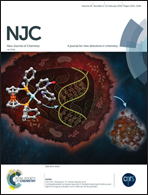Novel amphiphilic conjugates of p-tert-butylthiacalix[4]arene with 10,12-pentacosadiynoic acid in 1,3-alternate stereoisomeric form. Synthesis and chromatic properties in the presence of metal ions†
Abstract
For the first time amphiphilic receptors based on the 1,3-alternate stereoisomeric form of thiacalix[4]arene, bearing carboxyl/sulphonate polar headgroups on one side and 10,12-pentacosadiynoic acid (PCDA) residues on another side of the macrocyclic plane, were synthesized. It was shown that embedding of synthesized macrocycles in PCDA vesicles results in stable colloids with a size around 300 nm. The temperature of ultrasonication before UV irradiation has a critical impact on the packing of vesicles for better polymerization. The increase of calixarene content in PCDA vesicles causes a decrease in the degree of PCDA polymerization. Nevertheless, calixarene additives dramatically change the colorimetric response of photopolymerized PCDA vesicles toward metal ions. Vesicles with 10 mol% content of calixarene have significant colorimetric response toward lanthanide ions with a detection limit up to 8 μM. The colorimetric response in the series of lanthanide ions depends on the ionic radius, and the greatest response was found for the largest La(III) ion. It was found that binding of calixarene–PCDA vesicles with lanthanide ions results in the formation of large 1 μm aggregates followed by sedimentation. Thus, the mechanism of colorimetric response of calixarene-decorated polydiacetylene vesicles toward lanthanide ions includes the distortion of the calixarene cavity provoking perturbation of the PDA backbone accompanied by metal-induced aggregation of functionalized vesicles with sedimentation of particles. Therefore, calixarene–PCDA vesicles have great potential for the future design of bifunctional colloids with sensor and separation applications.
![Graphical abstract: Novel amphiphilic conjugates of p-tert-butylthiacalix[4]arene with 10,12-pentacosadiynoic acid in 1,3-alternate stereoisomeric form. Synthesis and chromatic properties in the presence of metal ions](/en/Image/Get?imageInfo.ImageType=GA&imageInfo.ImageIdentifier.ManuscriptID=C7NJ04099G&imageInfo.ImageIdentifier.Year=2018)


 Please wait while we load your content...
Please wait while we load your content...